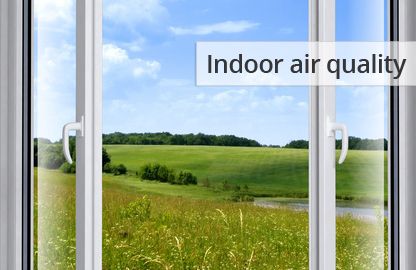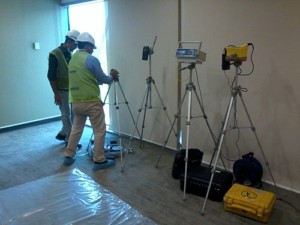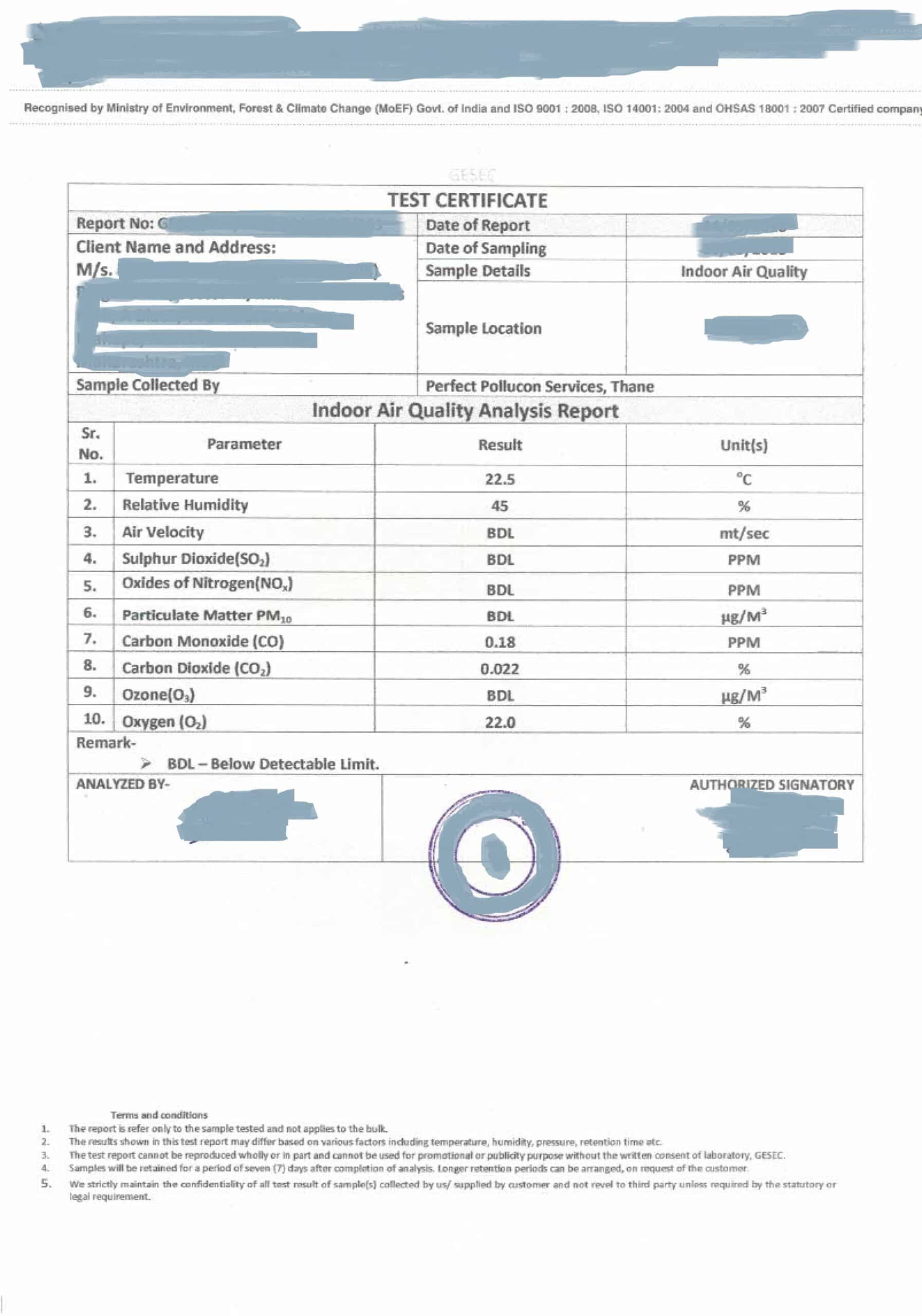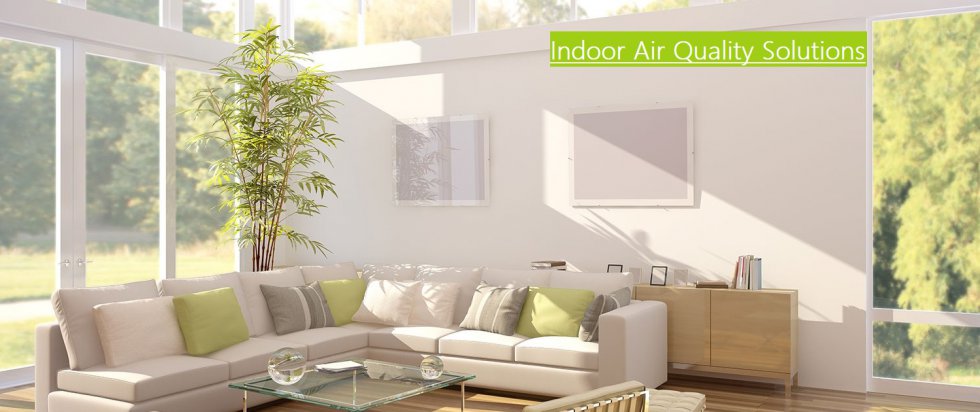Indoor Air Quality Monitoring or Testing (IAQ) is an essential process to determine the level of contaminants present in indoor air which can affect productivity & well-being of occupants.
Indoor air quality (IAQ) directly impacts health, productivity, and regulatory compliance. Monitoring IAQ helps identify pollutants like CO₂, VOCs, and PM2.5, ensuring a safe indoor environment.
With over 25 years of expertise, Perfect Pollucon Services provides accurate indoor air quality testing, helping businesses, industries, and commercial spaces improve air quality and meet regulatory standards.
Good and healthy Air Quality at the workplace can increase worker’s comfort, productivity and well-being. Perfect Pollucon Services checks indoor air by using Indoor air quality equipment for various harmful parameters for Homes and Industries. Regular indoor air quality testing can help to identify issues with air quality. Thousands of man-days are lost every year because of sickness due to poor Indoor air quality (IAQ).
Why Indoor Air Quality Monitoring is Essential?
Common indoor air quality issues include:
- High levels of CO₂ and VOCs, causing fatigue and health risks.
- Poor ventilation, leading to trapped indoor pollutants.
- Excess humidity, promoting mold growth and respiratory issues.
Perfect Pollucon Services helps organizations monitor and optimize indoor air quality for healthier spaces.
By Perfect Pollucon Services
Industry: IT Services & Data Center Management
Challenge: Elevated CO₂ levels and VOC traces affecting employee comfort
Solution: Comprehensive IAQ assessment, HVAC system optimization, and implementation of passive sampling techniques
Outcome:
- ✅ CO₂ levels reduced to optimal ranges
- ✅ VOC concentrations minimized
- ✅ Enhanced employee comfort and compliance with ISHRAE IAQ Standards
Key Learnings:
- 🔹 Regular IAQ assessments are crucial for maintaining a healthy work environment.
- 🔹 Optimizing HVAC systems enhances air quality and energy efficiency.
- 🔹 Utilizing passive sampling methods effectively identifies indoor air pollutants.
Indoor Air Quality Testing Services
Our Company (Perfect Pollucon Services) offers Indoor air quality (IAQ) Testing or Monitoring services for residential and commercial buildings. We certified to test / Inspect parameters Temperature, Humidity, carbon monoxide, contamination by microbes, particulates and volatile organic compounds etc. For Homes and offices.
Indoor Air Quality Monitoring By Perfect Pollucon Services
Indoor air quality is a growing concern & it directly affects human health. Gases like Carbon Monoxide, Contamination by microbes, Particulate or Volatile compounds diversely affect IAQ. Testing air q…
In India, 80% of people spend their time indoors

So, air quality is a high priority for employers, building owners to provide a safe work environment for employees.
Indoor Air quality can be affected by gases, particulate matters, bacteria, etc and Its quality can be improved by using filters, controlling source, proper ventilation.
Indoor air quality for households can be improved by cleaning carpets, It also depends on the number of members in family, pets, smokers etc.
Determination of Indoor Air Quality involves processes air sampling, testing and analysis of the collected sample for various parameters. A major source of indoor air pollution is burning of wood, dung, charcoal for cooking purpose in households.
Indoor Air quality denotes the quality of air inside buildings as represented by humidity, temperature, air pollutants conditions which may affect comfort, health and performance of occupiers.
Read More about Fugitive Emission Monitoring and Testing
Indoor Air Quality Monitoring & Testing Parameters
In indoor air Quality Measurement process mainly temperature, humidity and airflow (HVAC) are the comfort parameters.
For proper Radon, CO2, Mold, Harmful Chemicals, Dust (Respirable suspended particulate matter RSPM – PM10 and PM2.5), Volatile organic compounds (VOC) and Ozone needs to be monitor. Most of the indoor Environmental quality problems can be resolved by investigating the source of CO2 and indoor ventilation without measuring specific parameters.
Learn More about Ozone Monitoring
The indoor air quality monitoring parameters are divided into comfort parameters and contaminants parameters.
Comfort parameters consist of temperature, relative humidity and airflow. These parameters are directly connected to the comfort of a human being.
Indoor air quality monitoring & Testing also includes measurements of contaminants which are harmful to a human being.
Indoor Air Quality Standards (IAQS) India
| IAQM Parameters | WHO Guidelines | ASHRAE | OSHA | NAAQs/EPA |
| PM10 | 50 µg/m3 (24 hr) | – | 15 mg/m3 (total) | 150 µg/m3 (24 hr) |
| PM2.5 | 25 µg/m3 (24 hr) | – | 5 mg/m3 | 65 µg/m3 (24 hr) |
| SO2 | 20 µg/m3 (24 hr) | – | 5 ppm (8 hr) | 140 ppb(24 hr) 75 ppb(1 hr) |
| NO2 | 200 µg/m3 (1 hr) 40 µg/m3 (Annual) | – | 5 ppm (8 hr) | 53 ppb (annual) 100 ppb (1 hr) |
| CO | 10 ppm (8 hr) | 9 ppm (8hr) | 50 ppm (8 hr) | 9 ppm (8 hr) |
| CO2 | 1000 ppm | 5000 ppm | ||
| Humidity | 30% -65% | |||
| Temperature | 68°F – 74.5°F (20-23.6oC)(winter) 73°F – 79F° 22.8-26.1oC)(summer) – |
Other than above-mentioned pollutants it is always recommended to monitor VOCs (Volatile organic compounds), HC (Hydrocarbons), Methane, Formaldehyde, RSPM, O3 (Ozone), Asbestos etc.
However, measurement of other pollutants or contaminants can help to determine the source and target of pollutants which are not causing problems at present but can affect in long run.
Common Mistakes in Indoor Air Quality Monitoring
Top IAQ monitoring mistakes:
🔸 Ignoring ventilation assessments, which impact pollutant dispersion.
🔸 Using improper sensor placement, leading to inaccurate readings.
🔸 Failing to monitor airborne particulates, increasing health risks.Perfect Pollucon Services ensures precise IAQ monitoring, improving indoor environments and compliance.
Indoor Air Quality Monitoring & Testing Procedure
Before proceeding to the Indoor air quality monitoring procedure or method below are the points that need to keep in mind:
- Building type (Residential, commercial and sensitive building)
- Selection of pollutants which needs to be monitor
- Diagnosing health-related problems due to poor indoor air quality
- Building ventilation characteristic
- Number of people
- Activities in space (burning, smoking etc.)
- Outdoor pollution
- Health records or disease history of people
It is also important to know the schedule of monitoring, Specifications of monitoring equipment, Selection for sampling points etc.
Read More about Indoor Air Quality Testing Procedure.
Indoor Air Quality Testing Locations
The ideal sampling site depends on the purpose of sampling or monitoring. If the objective is to monitor indoor environmental quality in offices then location is preferred in office. If monitoring sites are representative of the monitoring site then the investigator must ensure that site is accurately representative of the environmental monitoring site.
More than one point in indoor air quality testing / Inspecting is preferred because air quality is not evenly distributed.

Indoor Air Quality Monitoring Time
The concentration of Contaminants in indoor air is related to humidity, temperature, human activities, therefore selecting time can be very influential in results. It is recommended that two hours of indoor air quality monitoring is best practice i.e. One hour in the morning and one hour in the evening.
24 hours /full day monitoring can be a better option when particular contaminants need to monitor.
Indoor Air Quality Monitoring & Testing Duration
The sampling duration of the site depends on the investigation of the acute effects of chronic effects on health. Monitoring duration can vary from 15 mins to several days depends on the type of data or sample required. The longer survey can give a more accurate and clearer picture of indoor air quality.
Number of Samples in Indoor Air Quality Testing
The number of samples or data points are selected before the indoor air sampling process based on the area and severity of pollutants. Normally in any event at first three samples are taken at the monitoring site and If the range of these exceeds more than 5% to 15% then additional samples or points can be monitored.
According to EPA (Environmental protection agency) sampling area of 25,000 sq. ft. on continuous floor meets the requirement of one sampling point. It is required to collect air samples for consecutive three days and average the results of each three days cycle for each air sampling zone.
Indoor Air Quality Testing Equipment
The equipment used in indoor air monitoring and the testing process must be regularly calibrated as per pollution control boards standards.
Due to the increase in time spent indoor, monitoring its quality has become a necessity. Also, It is very important to maintain temperature, humidity, ventilation and draft of a building. Indoor quality monitoring instruments helps to understand their range and based on collected data necessary actions can be taken to avoid health issues.

Below are some Indoor Air Quality Monitoring devices can be purchased to carry out Indoor air quality testing:
- Awair: Offers various indoor air quality monitors that measure key parameters like temperature, humidity, CO2, VOCs, and PM2.5.
- Airthings: Provides indoor air quality monitors with sensors for radon, CO2, humidity, temperature, and airborne particles.
- Foobot: Measures indoor air quality parameters such as VOCs, CO2, temperature, humidity, and airborne particles.
- PurpleAir: Specializes in real-time monitoring of outdoor and indoor air quality, focusing on particulate matter (PM2.5 and PM10).
- Netatmo Healthy Home Coach: Monitors indoor air quality, including CO2, humidity, temperature, and noise levels.
- uHoo: Tracks multiple indoor air quality parameters, such as temperature, humidity, CO2, VOCs, PM2.5, NO2, and ozone.
- Dylos DC1100: Focuses on measuring airborne particles (PM2.5 and PM10) for basic indoor air quality assessment.
- Foobot: Monitors key indoor air quality factors such as VOCs, CO2, PM2.5, temperature, and humidity.
- Temtop M10: A portable indoor air quality monitor that measures PM2.5, PM10, temperature, and humidity.
- AirVisual Pro: Tracks indoor and outdoor air quality, including PM2.5, CO2, humidity, and temperature.
- Eve Room: A compact indoor air quality monitor that measures VOCs, temperature, and humidity.
Learn more about Environmental Monitoring
Building and Ventilation Characterization
Size, the material used in construction, location, age, type, people and their activities information needs to be taken in sampling or monitoring process.
Ventilation parameters like airflow, Volume of air and Air velocity also need to be monitored.
Our Company monitor Indoor air quality in places such as new offices, Print rooms, Processing or manufacturing plants, clean rooms and workshops etc.
Indoor air quality services are vital for offices, schools, hospitals, and industrial facilities, ensuring a safe environment by monitoring pollutants and meeting health standards. These services also benefit hotels and commercial property managers by enhancing air quality for improved comfort and productivity.
Learnings from 25 Years of Indoor Air Quality Monitoring
✅ Real-time IAQ monitoring improves workplace health and safety.
✅ Proper ventilation assessments reduce indoor pollutants significantly.
✅ Regular IAQ audits help industries meet compliance and health standards.With decades of experience, Perfect Pollucon Services provides reliable indoor air assessments for improved air quality management.
Indoor Air Quality Monitoring & Testing Services by our Company
Impure Quality of air is very harmful to health can cause many diseases. So to check types and levels of pollutants are present in the air at home or offices, our company offers Indoor air quality Testing / Inspecting services or indoor air quality survey.
Perfect Pollucon Services is a Certified expert company to offer Indoor air quality management services and can be developed to meet your unique needs.
Want to know moew about How Perfect Pollucon Services conduct Indoor air Quality Monitoring ?
Residential and Commercial Indoor Air Quality Testing
Ensuring good indoor air quality is essential for health, comfort, and compliance.
With 25+ years of expertise, Perfect Pollucon Services delivers accurate IAQ assessments, helping organizations create safer indoor environments.
👉 Need expert indoor air quality monitoring? Contact us today!
Commercial Indoor Air Quality Testing
In Commercial Indoor Air Quality Testing Service we test indoor air for
- Chemical components like VOCs, formaldehyde, pesticides, SO2, CO2, CO, NOx, Ozone Monitoring etc.
- Biological Pollutants – mould, bacteria, fungus, allergens
- Particulate Matter- PM2.5, PM10, dust, etc.
- Moisture, Humidity
- Temperature
Residential Indoor Air Quality Testing
In Residential Indoor Air Quality Testing Service we test the air for following pollutants in home interiors:
- Chemical emissions (SO2, CO2, CO, NOx etc.)
- Moisture and Humidity
- Biological contaminants e.g mould, Bacteria, fungus, allergens
- Temperature
- Air Velocity i.e.e Ventilation
Best Indoor Air Quality Monitor for Mold
Some of the well-regarded indoor air quality monitors for mold detection include:
- Foobot: Foobot is known for its accuracy in detecting mold spores and other pollutants. It provides real-time data and alerts through a smartphone app.
- AirVisual Pro: This monitor offers comprehensive indoor air quality measurements, including mold detection. It provides real-time data and can be connected to your smartphone for remote monitoring.
- Blueair Aware: Blueair’s indoor air quality monitor detects various pollutants, including mold, and provides information through a smartphone app. It offers both real-time and historical data.
- Airthings Wave Plus: While not exclusively designed for mold, this monitor measures various indoor air quality parameters, including volatile organic compounds (VOCs) that can be associated with mold growth.
- uHoo: uHoo is a versatile indoor air quality monitor that tracks various pollutants, including mold spores. It provides detailed insights and alerts through a smartphone app.
When choosing an indoor air quality monitor for mold detection, consider factors such as accuracy, the range of pollutants it detects, ease of use, connectivity options, and customer reviews. Additionally, it’s a good practice to ensure that the monitor you choose fits your specific needs and the size of the space you intend to monitor. Always check for the latest models and reviews to make an informed decision.
Wondering what type of sources pollute Indoor air? We explaned it here
How much does a Home Indoor Air Quality Test Cost?
In India, Recently after seeing reports on how air quality is getting worse day by day, people have become more aware of air they breathe. Recently air purifier has become a necessity in every household.
People are often confused to check the quality of Air at home or offices. They end up spending high amount with no effective outcome. Hence it is advised to check on cost of Indoor Quality Testing companies.
Cost for Indoor air quality testing depends on the area for you want to test IAQ and Number of parameters. It is recommended to consult a couple of Certified Indoor air quality experts before hiring for Home and Industrial Air Quality Testing.
Ozone Indoor Air Quality Monitoring
Indoor ozone monitoring is essential for maintaining healthy air quality, as ozone can negatively impact respiratory health even at low concentrations. It helps in identifying ozone levels generated by indoor sources like air purifiers or printers and outdoor infiltration. Monitoring ensures timely actions to reduce exposure, especially in environments like hospitals, offices, and homes. Advanced ozone monitoring solutions offer precise measurements to maintain safe levels, fostering a healthier indoor environment. Learn more about its importance and technology at PPS Thane’s blog on ozone monitoring.
Indoor Air Quality Monitoring PPT Presentation
Indoor Air Quality Assessment Report
We provide Indoor Air Quality Assessment Report after analyzing samples in our laboratory and provide analysis report as per below format.
Below report contains information about Client name, Sampling location, date, etc. It also includes results of Physical parameters (like Temperature, Humidity, etc.) and Chemical Parameters (like Sulphur dioxide, Nitrogen Dioxide, etc.) post-analysis done in Laboratory.
Below is the sample Indoor air quality report is offered for Home and Industrial Air quality testing.

✅ Reviewed by Our Expert Leadership Team
This service offering is created and reviewed by our senior team of environmental professionals with 10–40 years of experience in pollution control, regulatory compliance, and monitoring services.

Tanaji S. Gajare
Founder & Chairman
40+ years in air & water monitoring, sustainability leadership

Anil Shelke
Executive Director
30+ years in compliance, audits, and ETP/STP operations

Kunal Gajare
Chief Sustainability officer
10+ years in stack monitoring, MPCB/MoEF clearances, EIA
Frequently Asked Questions
As per CPCB, Good AQI is 0 – 50 falls under Minimal impact. Air quality is considered satisfactory in the range of 51-100 and it can pose little or no risk with minor breathing discomfort to sensitive people. Moderate AQI is 101-200 that can cause breathing discomfort to people with Asthma, Lungs and heart disease. Above Moderate i.e., below AQI 200 Air Quality is acceptable.
If you want to measure air quality at home or office then you need an indoor air quality monitor. These tools will monitor the Concentration of different gases present in the air and provide readings on-screen in real-time. The limitation of handheld devices is they can’t measure more than 3-4 gases in a device. If you want a detailed report and analysis then you can call a professional Environmental monitoring service provider.
Air quality is measured in the Air Quality Index. As per CPCB, if AQI is more than 200 then it can cause breathing discomfort, respiratory illness and it also affects healthy people and seriously impacts those with existing diseases. AQI more than 400 is considered very severe and it can cause permanent damage to human health.
According to EPA, Common indoor pollutants are high moisture,volatile organic compounds (VOCs), combustion products, radon, pesticides, dust particles (PM), virus, and bacteria.

